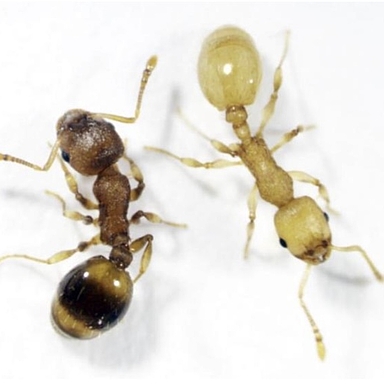Project 13.3

- PhD student: Beka Chitadze
- Supervisor: Susanne Foitzik
- Further TAC-members: Helen May-Simera, Jan Padeken, Joseph Colgan
- Research Group
My PhD project examines how the parasitic tapeworm Anomotaenia brevis manipulates its intermediate host, the ant Temnothorax nylanderi. Infection alters host behavior, physiology, and lifespan, with infected ants showing reduced activity, extended lifespan, and a less melanized and sclerotized cuticle. My project focuses on age-controlled transcriptional changes, including alternative splicing, and the role of extracellular vesicles (EVs) in host manipulation, using an integrative approach combining transcriptomics, cell biology, and bioinformatics.
Parasitic relationships typically reduce host fitness, yet many parasites have evolved strategies to modulate host immunity and optimize transmission. Since premature host death limits parasite spread, parasites often exploit host resources while minimizing harm (Combes, 1997). Cestodes have undergone substantial morphological and functional changes through coevolution with their hosts (Olson et al., 2001). Their complex life cycles involve stage-specific adaptations, such as immunomodulation and metabolic adjustments to host-derived nutrients (Sulima et al., 2018).
Phenotypic plasticity enables organisms to modify traits in response to environmental or biological cues. Parasites exploit this plasticity to alter host phenotypes in ways that promote transmission. For example, the nematode Myrmeconema neotropicum causes Cephalotes atratus ants to turn red, increasing predation by birds (Poinar & Yanoviak, 2008). Similarly, the fungus Metarhizium increases reproduction in infected Cardiocondyla obscurior queens (Giehr et al., 2017). These cases show how parasites can affect host morphology, behavior, and reproduction.
A central question in my research is how the cestode Anomotaenia brevis manipulates its intermediate host, the ant Temnothorax nylanderi. Infected ants exhibit reduced melanization and cuticle sclerotization, likely due to interference with the tyrosine metabolic pathway during pupation, as infection occurs during larval development (Beros et al., 2015). Previous studies revealed infection-related gene expression differences in the brain and fat body (Feldmeyer et al., 2016; Sistermans et al., 2023). However, because infected ants live longer, earlier work could not control for age. By analyzing transcriptional activity in newly emerged infected and uninfected ants, I can now account for age. Using RNA sequencing, I will examine gene expression changes associated with infection and phenotype, including alternative splicing.
Cestodes remain transcriptionally active in the cysticercoid stage and secrete proteins that may extend host lifespan (Beros et al., 2016, 2021; Hartke et al., 2023), suggesting that A. brevis manipulates host biology by modulating protein expression. Recent findings show that parasitic worms release extracellular vesicles (EVs) containing proteins and small RNAs that influence host physiology. For instance, Brugia malayi secretes EVs into Aedes aegypti, affecting the melanization pathway (Loghry et al., 2023). While indirect evidence suggests that A. brevis also produces EVs, their role remains unresolved.
During my PhD, I aim to determine whether A. brevis uses EVs to deliver effector molecules. I will characterize EV contents and assess their role by injecting EVs into uninfected ants to test for physiological and behavioral effects. This research will clarify the molecular mechanisms by which parasites manipulate host traits.